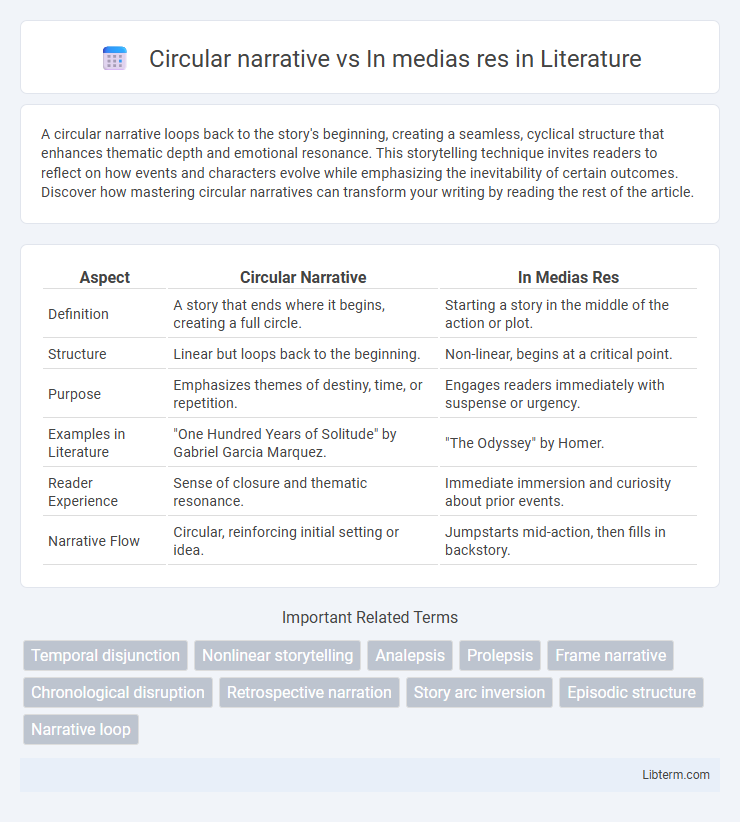A circular narrative loops back to the story's beginning, creating a seamless, cyclical structure that enhances thematic depth and emotional resonance. This storytelling technique invites readers to reflect on how events and characters evolve while emphasizing the inevitability of certain outcomes. Discover how mastering circular narratives can transform your writing by reading the rest of the article.
Table of Comparison
| Aspect | Circular Narrative | In Medias Res |
|---|---|---|
| Definition | A story that ends where it begins, creating a full circle. | Starting a story in the middle of the action or plot. |
| Structure | Linear but loops back to the beginning. | Non-linear, begins at a critical point. |
| Purpose | Emphasizes themes of destiny, time, or repetition. | Engages readers immediately with suspense or urgency. |
| Examples in Literature | "One Hundred Years of Solitude" by Gabriel Garcia Marquez. | "The Odyssey" by Homer. |
| Reader Experience | Sense of closure and thematic resonance. | Immediate immersion and curiosity about prior events. |
| Narrative Flow | Circular, reinforcing initial setting or idea. | Jumpstarts mid-action, then fills in backstory. |
Introduction to Narrative Structures
Circular narrative structures return to the story's starting point, creating a loop that emphasizes themes of fate or inevitability, while In medias res plunges directly into the middle of the action, engaging readers through immediate conflict and suspense. Circular narratives often reveal character development and plot through recurring motifs, whereas In medias res relies on flashbacks or exposition to fill in background details. Both structures serve distinct purposes in narrative pacing and thematic emphasis, shaping audience interpretation from the story's opening moments.
Defining Circular Narrative
Circular narrative is a storytelling technique where the story ends at the same point it began, creating a sense of closure and emphasizing themes of fate or inevitability. This structure contrasts with in medias res, which starts the story in the middle of the action, often revealing background information through flashbacks. Circular narratives enhance thematic depth by reinforcing cyclical patterns within the plot and character development.
Understanding In Medias Res
In medias res is a narrative technique that begins a story in the middle of the action, immediately engaging the audience without traditional exposition or background. This approach contrasts with circular narratives that start and end at the same point, emphasizing thematic cycles. Understanding in medias res enhances comprehension of plot development by focusing on critical moments, creating suspense, and prompting the audience to piece together prior events through flashbacks or dialogue.
Key Differences Between Circular Narrative and In Medias Res
Circular narrative structures loop back to the beginning, creating a sense of completion and thematic reinforcement by revisiting initial events or scenes. In medias res starts the story in the middle of the action, immediately engaging the audience without prior exposition, then typically uses flashbacks or backstory to fill in context. Key differences include the narrative timing and structure: circular narratives emphasize cyclical storytelling and thematic continuity, while in medias res prioritizes immersive, suspense-driven openings followed by narrative revelation.
The Purpose and Effect of Circular Narratives
Circular narratives emphasize thematic resonance by returning to the story's starting point, creating a sense of closure and inevitability that deepens the audience's understanding of character development and plot progression. This structure reinforces key motifs and highlights cyclical patterns in human behavior or fate, often evoking reflection and emotional impact. In contrast to in medias res, circular narratives prioritize full-circle storytelling that enriches meaning through repetition and renewed context.
The Impact of In Medias Res on Storytelling
In medias res dramatically enhances storytelling by plunging audiences directly into the heart of the action, creating immediate engagement and suspense. This technique disrupts traditional chronological order, allowing for dynamic character development through strategic flashbacks and revelations. Compared to circular narrative, in medias res prioritizes urgency and immersion, compelling viewers or readers to piece together the story's full context actively.
Examples of Circular Narratives in Literature and Film
Circular narratives appear prominently in literature such as Joseph Conrad's "Heart of Darkness," where the story ends in the same setting it began, emphasizing thematic closure and character reflection. Films like "Memento," directed by Christopher Nolan, use a circular narrative structure by presenting events in reverse chronological order, guiding viewers through the protagonist's fragmented memory while ultimately returning to the starting point. These examples highlight the technique's power to enrich storytelling by looping back to initial scenes, creating a cohesive and thought-provoking experience.
Notable Works Using In Medias Res
Notable works using in medias res include Homer's *The Iliad*, which begins amidst the Trojan War, and Dante Alighieri's *Divine Comedy*, starting in the middle of the protagonist's spiritual journey. These narratives engage readers immediately by dropping them into pivotal moments, contrasting with circular narratives that loop back to the beginning for thematic emphasis. In medias res emphasizes action and suspense, enhancing storytelling dynamics in epic and modern literature.
When to Choose Circular Narrative vs In Medias Res
Choosing a circular narrative suits stories emphasizing themes of destiny, memory, or cyclical time, where the ending reflects or echoes the beginning to reinforce meaning. In medias res is ideal for action-driven plots requiring immediate engagement, plunging readers directly into the middle of the conflict to create suspense and momentum. Writers select circular narratives for emotional or philosophical depth, while in medias res works best for tension and pacing in dynamic storytelling.
Conclusion: Choosing the Right Structure for Your Story
Choosing between a circular narrative and in medias res depends on the desired impact and pacing of your story. Circular narratives emphasize thematic closure by returning to the starting point, enhancing reflection and depth. In medias res immediately engages readers by dropping them into the action, maintaining suspense and momentum throughout the plot.
Circular narrative Infographic

 libterm.com
libterm.com